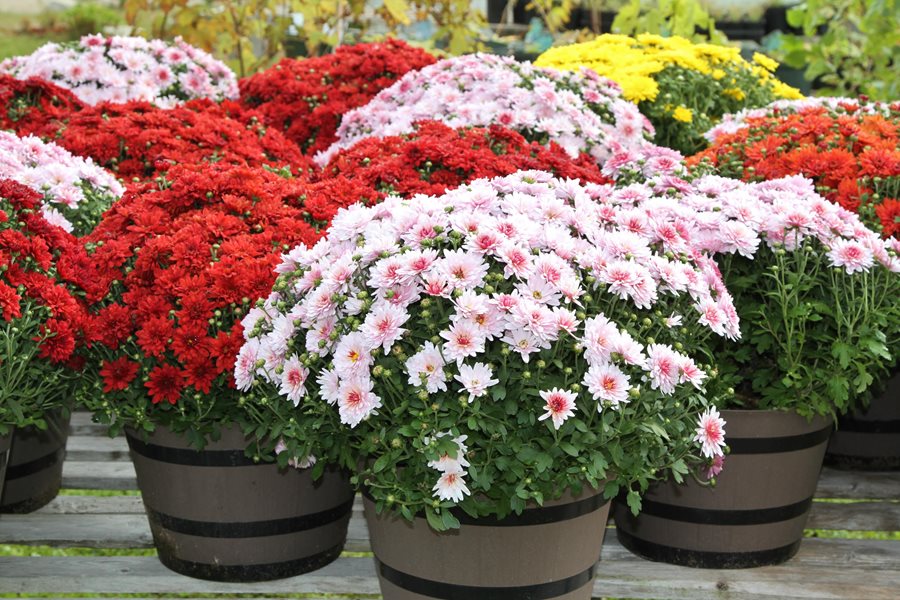Not be confused with moms (as in mothers), mums are some of the world's most popular potted plants. Chrysanthemums, or mums for short, add a splash of color to any indoor or outdoor medium and are great plants to have in general. Today we're going to show you how to care for mums either indoors or outdoors!
Their popularity stems from the fact that they're just so pretty, especially during the fall! They come in a variety of colors from red, yellow, pink, and white. Mums will thrive easily outdoors in pots or directly in a garden bed. If you want your mums to last as long as possible, always purchase ones where the blooms haven't opened yet. This is true whether you're keeping your mum flowers indoors or outdoors.
How to Care for Mums AKA Chrysanthemums

Most mums will bloom naturally in the spring, and, when cared for properly, can actually stay in bloom for a long time. Mums are hardy in USDA zones 5 through 9, but there are some varieties that can't survive outdoors, especially if frost hits. You can purchase garden mums from your local nursery and they are usually available in early spring.
Sunlight:
Ensure that your mums bloom for a longer time by placing them near a window where they will receive indirect sunlight. If placed outdoors, they should receive only direct morning sunlight and afternoon shade. In hotter climates, mums should be placed in an area where they will receive partial sunlight.
Climate:
Mums don't like extreme heat or extreme cold, so they'll thrive when temperatures are between 70-75F. Water your mums only when the top 1 inch of soil is dry, so be sure to check the soil daily. When watering, do so until water starts draining from the bottom of the pot. Discard any water that's been leftover in the bottom of the tray.
After the mums wilt, be sure to cut off the flowers – this will encourage more bloom. If the temperature doesn't drop below 32F in the winter, you can leave your potted mums outdoors. If the temperature does drop below 32F, winterize them by placing them indoors in indirect sunlight. In the winter, only water enough so that the soil doesn't dry out entirely.
Soil:
Chrysanthemums prefer well draining soil. If grown in a pot, ensure that your pot has good drainage holes. For best results, grow your mums in a soilless mixture with one part peat moss, one part perlite, and one part coarse builder's sand. The reason why mums love this type of soil is because it provides excellent drainage and mums don't like to sit in wet soil. Additionally, you can also purchase soilless mix from your local nursery.
Fertilizing Mums:
Fertilize the mums in the spring once new growth appears. Water them with a soluble, balanced fertilizer such as a 10-10-10 blend once a month. Fertilize monthly until the middle of summer once the buds begin to gain color.
Mums Maintenance:
Remove the tips of new stems once they are about 5 inches tall. Continue to pinch them back to about 5-6 inches in height from spring to the middle of summer. This will encourage faster and bushier growth. Deadhead your mums on a regular basis to encourage new growth. Use your fingers or pruning shears to remove any spent flowers. It's best to remove them above the next set of leaves on the stem. Additionally, you may also remove dead leaves. Every three years, repot the moms so that they have more space to grow.
Pot Size:
If you want your mum plant to last a long time, make sure that it's in an adequately sized pot along with a good potting soil mix. The pot should also have good drainage. Take the time to repot your mums after purchasing them – the pots they come in are usually too small for them to adequately grow.
Watering Mums:
Be sure to water close to the roots, saturating the soil well, and being careful not to wet the leaves. Don't just water from the top and let water sit at the bottom as this can cause fungal diseases. Water your mum plants frequently, especially during the growing season or after purchasing them from a garden center. Then, once they're most established, give them about an inch of water a week. If you see the leaves start to wilt, water more frequently.
Transplanting Mums:
Depending on what zone you live in, you should transplant your mums only in the spring. If you live in a warmer climate, you may transplant any time of the year, provided there is no chance of frost. For outdoor varieties, add extra mulch to protect the plant and add moisture.
So now that you know how to care for mums, it's time to roll up your sleeves and get to planting! Like this post? Share, Pin, and Comment Below 🙂


















